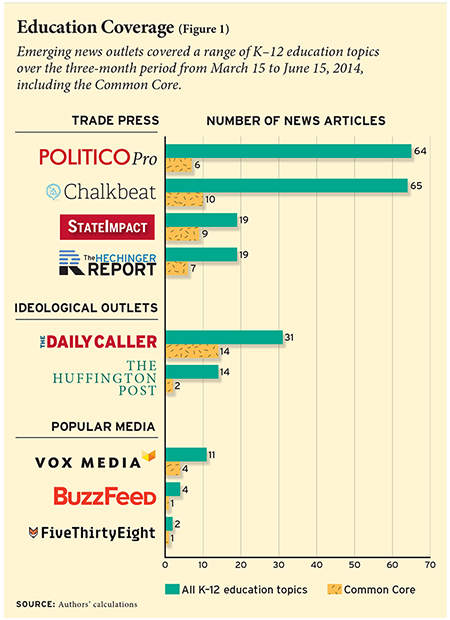The conventional wisdom is that the news business is in a death spiral, taking with it serious reporting about all manner of public policy issues. But all hope is not lost, for there’s been a recent, and in my view, surprising revival of education reporting, a resurrection driven by a new breed of journalism (see Figure 1).
 Some of these new outlets produce so much education content—much of it quite wonky—that they should now be considered part of the trade press. That’s certainly the case for both Politico Pro and Chalkbeat. Politico Pro, which launched its education coverage in the summer of 2013, pumps out loads of ministories, and at least a handful of meaty ones, almost every day, plus its “Morning Education” newsletter, which lands in the in-boxes of the powerful and influential. Chalkbeat, the result of a merger between New York City’s GothamSchools and EdNews Colorado (with outlets in Indiana and Tennessee, too), is a grant-funded entity committed to doing regular, in-depth reporting in a given location—a geographically based Education Week, if you will. The Hechinger Report and StateImpact are cousins of these news outlets. Hechinger places national, long-form stories in prominent publications across the country; StateImpact taps into the infrastructure of National Public Radio affiliates in Florida, Indiana, and Ohio to go deep in their home states (on education and other issues).
Some of these new outlets produce so much education content—much of it quite wonky—that they should now be considered part of the trade press. That’s certainly the case for both Politico Pro and Chalkbeat. Politico Pro, which launched its education coverage in the summer of 2013, pumps out loads of ministories, and at least a handful of meaty ones, almost every day, plus its “Morning Education” newsletter, which lands in the in-boxes of the powerful and influential. Chalkbeat, the result of a merger between New York City’s GothamSchools and EdNews Colorado (with outlets in Indiana and Tennessee, too), is a grant-funded entity committed to doing regular, in-depth reporting in a given location—a geographically based Education Week, if you will. The Hechinger Report and StateImpact are cousins of these news outlets. Hechinger places national, long-form stories in prominent publications across the country; StateImpact taps into the infrastructure of National Public Radio affiliates in Florida, Indiana, and Ohio to go deep in their home states (on education and other issues).
Then there are the more ideological outlets: Huffington Post on the left and the Daily Caller on the right. The Daily Caller, in particular, has come on strong of late; among Washington-based media outlets, only the Washington Post gets more readers. The Daily Caller’s education coverage is hyperkinetic (writers are rumored to be paid based on clicks), not to mention schizophrenic, veering between hot policy issues (mostly Common Core) and the schoolhouse scandal of the day (“Drunk Teacher Pulls Knife on Students, Demands Fast-Food”).
The other entrants—BuzzFeed, FiveThirtyEight, and Vox—are just getting started with their education coverage. BuzzFeed has a focus on the “business of education” and to date its articles center mostly on higher education. FiveThirtyEight, created by über–data geek Nate Silver, shows a lot of potential but has only produced two education stories so far (understandable since it doesn’t have a dedicated education reporter). Of the three, Vox has shown the most interest in K–12 happenings, with a mix of the serious (“How Racial Inequality in Education Persists 60 Years after Brown v. Board of Education”) and the silly (“Why a Florida Lawmaker Thinks Common Core Tests Will Make Kids Gay”).
Whether this education-reporting revival is a renaissance or regrettable certainly depends on your point of view. It’s easy to look down one’s nose at the short, “shareable,” and sometimes salacious coverage of some of these upstarts. Then again, some of the best in-depth coverage, and the most knowledgeable writers, call these outlets home, too. And it’s rarely smart to bet against Nate Silver.
Michael J. Petrilli is president of the Thomas B. Fordham Institute.
This article appeared in the Winter 2015 issue of Education Next. Suggested citation format:
Petrilli, M.J. (2015). A New Breed of Journalism: Education coverage is on the rise. Education Next, 15(1), 82.


